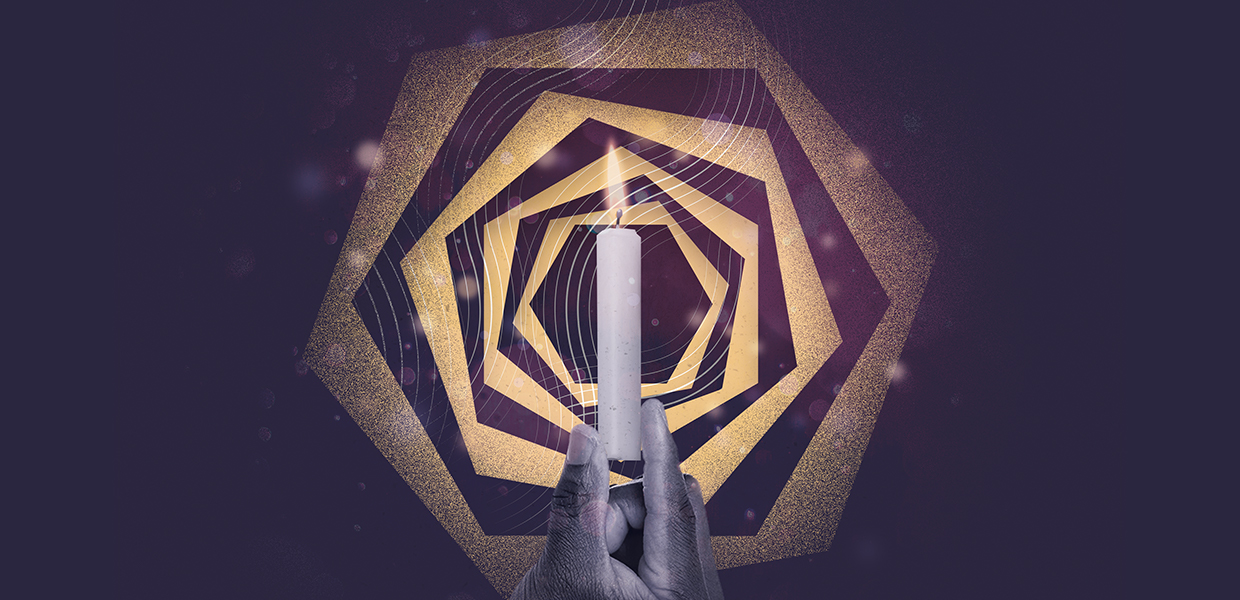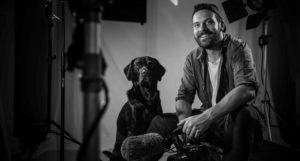
Concerts by Candlelight
Scottish Ensemble’s annual Concerts by Candlelight tour has long been a well-loved favourite in our audiences’ calendars. While we don’t think that squeezing into cosy pews in Scotland’s beautiful churches and cathedrals will be possible this year, we hope you’ll join us for a special filmed version, which premiered on Wednesday 16 December. Light your own candles (carefully!) and set aside an evening to enjoy a spectacular film, rich in glowing atmosphere and steeped in solace.
At the end of a year that has felt out of balance, this year’s programme brings comfort through a sense of symmetry. Patterns, reflections and partnerships will feature in conversational concerti for multiple instruments, intertwining canons and partitas, and music by J.S. Bach, Anna Clyne, Arvo Pärt, Edmund Finnis and George Crumb.
- J.S. Bach
Ricercar à 6 from The Musical Offering - Steve Reich
Duet - J.S. Bach
Canon at the sixth - J.S. Bach
Canon at the fourth, in contrary motion from Goldberg Variations - George Crumb
God Music from Black Angels - Edmund Finnis
The Centre is Everywhere - Arvo Pärt
Summa - J. S. Bach
Canon in Augmentation and Contrary Motion from The Art of Fugue - Anna Clyne
Prince of Clouds - Mykola Leontovych arr. Daniel Pioro
Carol of the Bells
Looking for our upcoming concerts?
You are currently on an archive page for our 2020 Concerts by Candlelight tour, click bellow to view our 2023 tour page with up to date ticket details and repertoire.
- Wed 16 December 7:30 pmOnline Filmed Performance
The Trailer
Watch a preview of our spectacular filmed festive concert, rich in glowing atmosphere and steeped in solace.
A Virtual Welcome!
from Jonathan Morton, Artistic Director
This time of year focuses our minds on the cyclical nature of our calendar, as we look forward to the reiteration of cherished traditions. Our candlelit concerts have evolved, established roots and become an event we all treasure – performers and audiences alike.
The custom of exchanging gifts is echoed in some of the music you will hear – from Bach’s ‘Musical Offering’ to Anna Clyne’s ‘Prince of Clouds’; a piece she wrote whilst contemplating that the ‘transfer of knowledge and inspiration between generations is a beautiful gift’. This is a graceful reminder that the music we are lucky to perform and listen to can be thought of as a gift from present and past generations, a sonic legacy to enjoy, care for, and pass on.
At the core of the programme is Edmund Finnis’s intensely mesmerising The Centre is Everywhere. From here, concentric circles radiate outwards, each one encompassing a pair of works that reflect each other in subtle ways: two works turned towards the sacred; a set of intricate canons; a pair of violin duets; and two musical gifts (the Musical Offering from Bach, and a festive farewell in the form of Carol of the Bells). This overall sense of symmetry becomes distilled into stricter geometric expression in pieces by J.S. Bach, Steve Reich, and Arvo Pärt, where discipline and freedom push and pull, in an intoxicating dance that expands the boundaries of the possible.
Given that you will experience the music as a filmed performance, I couldn’t resist including an animated graphic score by Stephen Malinowski. I hope you will enjoy the way his beautiful visual representations reveal the mind-bending musical processes in J.S. Bach’s Art of Fugue.
Thank you for being part of this Scottish Ensemble tradition. We can’t wait to be able to share live performances again, hopefully in the not-too-distant future.
Performers
- Director/Violin
Jonathan Morton - Violin
Daniel Pioro, Liza Johnson, Tristan Gurney, Laura Ghiro, George Smith - Viola
Jane Atkins, Andrew Berridge, Kathryn Jourdan - Cello
Alison Lawrance, Naomi Pavri, Duncan Strachan - Bass
Diane Clark
Film Credits
- DoP/ Director
Richard Watson - Camera Operator
Stuart Edwards - Camera Operator
Ray Bird - Music Director
Jonathan Morton - Recording Engineer
Jonathan Green - Animated Score
Stephen Malinowski - Filmed at Greyfriars Kirk, Edinburgh by Flux Video
Notes on the Music
by Rosie Davies
Standing at the outer edge of our programme, the first notes of Bach’s Ricercar lead us, with disarming simplicity, into one of the greatest fugues ever written. Plotted for six perfectly-aligning parts – a feat rarely tried, and even more rarely pulled off – one of the most astonishing elements of Bach’s music, and in fact many of the pieces in our concert of mirrors and patterns, is the way in which deep complexity produces an almost meditative clarity.
Ricercare means ‘to seek out’, in Italian, and we find each voice calling for the next, creating a perpetual movement at the same time as a hypnotic, centred stillness. Taken from his Musical Offering, it is a gift, to be enjoyed whole, or unwrapped layer by layer.
Take another step, and immerse yourself in the dopamine glow of Steve Reich’s Duet, still warm with the legacy of Bach’s endlessly influential counterpoint. Locked together in amicable imitation, the two soloists throw ropes of sunshine back and forth, sometimes jumping in to finish a sentence, at other times waiting for affirmation. The effect is a lattice of light, reflecting and refracting across the solid, weighty comfort of the strings below, propelling us forwards –
– forwards, into another chamber of mirrors, where we invite you to begin to notice more closely the intricate lace of their structure. In the 18th of Bach’s cherished Goldberg Variations, you may be able to hear how the voices mimic each other: the opening voice is soon followed by a second, remaining close and consistent, a logical shadow. In the 12th variation, the second voice also imitates the first – but upside down, with the pitch moving in the opposite direction, making it extremely impressive, and immediately harder to follow using only our ears.
But, more on this later, because we’ve arrived at the gate of the sacred core of the programme, a triad of pieces reminding us of the ability of music to conjure the unspoken, the unimagined, the unimaginable.
As critic George Grella summarises: “Part astronomer and part alchemist, Crumb’s music, more than that of most every other composer, creates its own universe, one that sees science and magic as intimate companions.”
In this movement – God Music, from Crumb’s astonishing Black Angels – water-tuned glasses, played with bows, create an ethereal choir and a sound somewhere between existence and non-existence. The cello, wincingly high yet beautiful, sings from another place. Together, suspended in silence, they form a whole that both can, and cannot, be analysed.
And so we are led to Edmund Finnis’s equally mysterious entity, coiled at the heart of our programme. Like the works on either side, The Centre Is Everywhere offers not so much a piece of music as an experience. In all three, silence, and absence, are as important as presence and – somewhere, somehow – in listening to Finnis, we absorb a sense of grappling with questions that have been embedded deep in human consciousness, and philosophical thinking, for centuries.
Infinity, the shape and form of God, the notion of a being who can be everywhere and nowhere, everything and nothing… Much like our blind, human fumbling around how to define the unknown boundaries of our existence, Finnis’s music is the stuff no-one might ever be able to describe in words, and yet we try anyway.
Here’s one attempt.
The Centre Of Everywhere appears from nowhere, unfurling and growing, tentative, as if alive.
It tests, as it grows, allowing sensations to exist, arise, flow.
Moments of solace are interrupted by surprise.
Hints of memories flicker on the subconscious, neutral.
Nagging little fragments, things we can’t forget, don’t realise we’re remembering.
A melancholy warning, creeping in, overtakes your focus before you know it, remnants of that nagging memory, stopping here and cradling you, simultaneously pausing and pushing on.
From that point, nothing is the same.
Something larger and elemental has risen from the deep, ever-present but now it has grown and gathered and solidified beneath the frills of the surface. It drives through like a plough through snow, trying once, trying again, passive, calm.
The mind is provoked into eddies, whirls, faster, higher, caught in thought – until.
Until it is drowned, subjugated, stilled, and it fades into everywhere.
Nothing is the same, and everything is the same.
Another is Manchester Collective’s poetic offering, penned after commissioning (and then falling in awe with) the piece in 2019: “His music is a breath on the wind. His music is light dancing on water. His music is a lover’s whisper in the dead of night. It is both beautiful and strange.”
On the other side of our symmetry line rests Arvo Pärt’s Summa, which he deemed “the most strict and enigmatic” of his tintinnabuli compositions. As with Bach’s complex counterpoint, Pärt’s compositional system creates a simultaneous feeling of stillness and movement, of ambivalence and spirituality; and, like Crumb, we’re left with the undeniable feeling of a musical alchemist at work. Inspired by the Latin Credo text, its surface simplicity rocks and cradles us, a powerful evocation of the all- encompassing purity of faith.
Stepping outwards, we find ourselves revisiting Bach’s mesmeric world of mirrors, this time inviting you to consider how our brains attempt to understand the musical patterns they absorb.
In this canon from Bach’s epic Art of Fugue, we can clearly hear the opening voice. The second one soon imitates – but it’s upside down, and at half the speed, and… our brains are swiftly, pleasantly lost within this precisely-plotted aural kaleidoscope. It is, in the words of Jonathan Morton, “a source of endless wonder” – which is perhaps why artists have been so drawn to trying to decipher and splay its code in visual form. We particularly fell for the beautiful work of artist Stephen Malinowski – we hope you will, too.
As with Reich’s Duet, Anna Clyne’s Prince of Clouds plays with the idea of musical cells being passed back and forth; “I was contemplating the presence of musical lineage – a family-tree of sorts that passes from generation to generation”, said Clyne.
But in contrast to Reich’s hazy, cradling warmth, the sweet serenity of the opening is interrupted by an electrical storm – all lightning stabs, sudden currents, disjointed whims, beginnings but no endings, and our need for mirrors, for symmetry, the completion of the pattern, is disrupted.
We’ll complete ours now. We began with an offering, so we’ll end with a gift: an arrangement, by Daniel Pioro, of a carol that sweeps us forwards with positivity, verve and spark.
Carol of The Bells was originally a song for the new year, not Christmas. Derived from a Ukranian folk chant, it tells of a swallow flying into a household to tell the family of the plentiful, abundant year awaiting them (its original title comes from the Ukranian for ‘bountiful’).
Following a sweet chorale comes the electric shiver of excitement of that famous motif – spiked with the vibrancy, exuberance and hope of an ice-bright star in a jet-black sky. As Daniel states, “it should sound like wind whipping round the sky, a whirling snowstorm, the dark, impish, mischievous excitement of festival…”
We hope it propels you outwards, onwards and forwards into an abundant 2021.
Resources & Downloads
Concerts by Candlelight - Programme
1.22 MB
